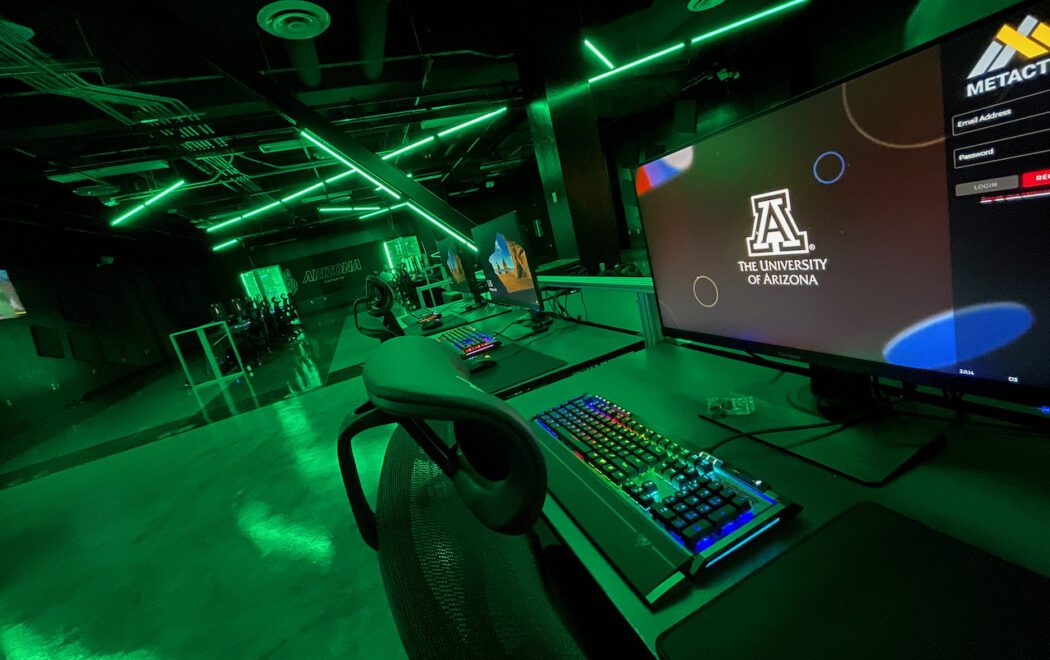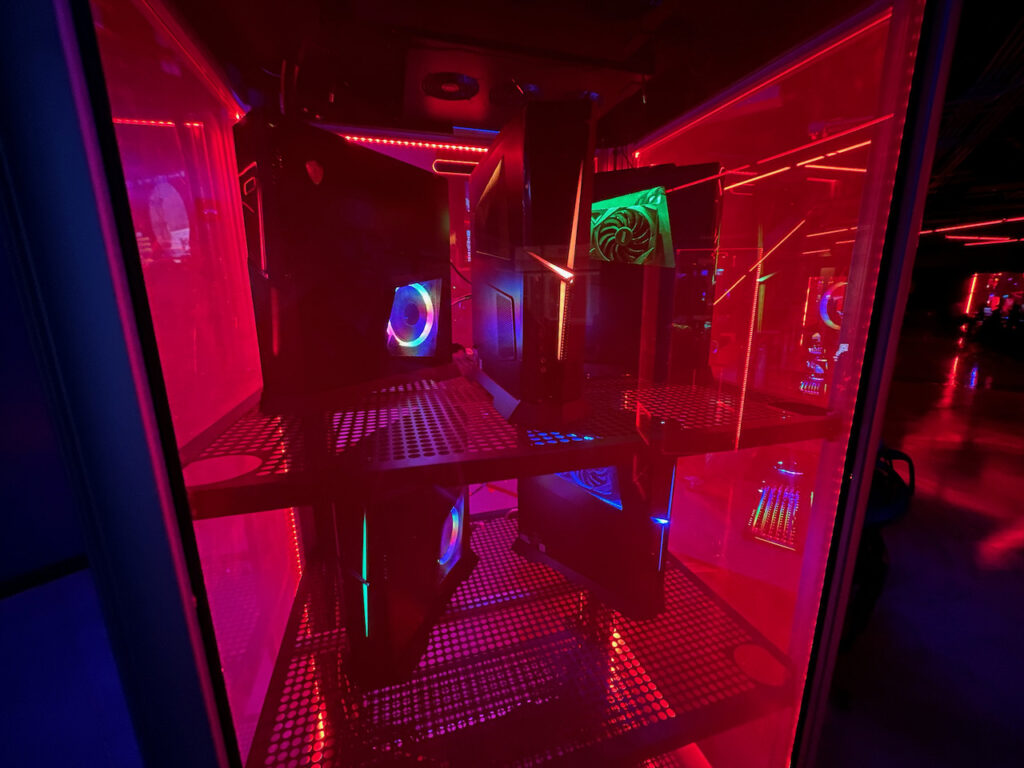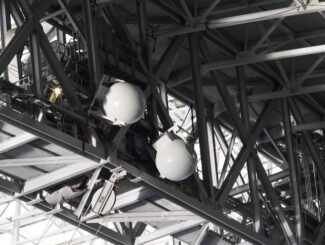
After bursting onto the sporting mindset a few years ago with a huge bang, the idea of live-attendance “esports events,” or fans watching competitive organized gaming, has had some problems living up to the hype.
While projections of Super Bowl-sized crowds assembling to watch live gaming events haven’t quite materialized yet, the undeniable popularity of competitive gaming, from casual play, to collegiate events, to pro leagues, has many organizations scrambling to figure out the best way to build special-purpose facilities to support all the needs of competitive gaming; from instruction and training to actual events.
Like almost all other competitive sports, esports worldwide were affected by the Covid-19 pandemic, which put a halt to almost all live-attendance events for most of the past year. But as things start to return to normal, many supporters — especially U.S. colleges — are looking for ways to build facilities that can not only host live events, but act as training or casual-play facilities that can realize some revenue from paid-play time or corporate sponsorships.
For the University of Arizona, a company called 1337 Facilities — we’ll explain the name in a bit — led by longtime sports technology deployment expert Bob Jordan, has developed a model for building a flexible esports facilities using existing university space. By using uniquely designed furniture manufactured by AmpThink that can quickly transition from tournament setting, to team training, to class-type instruction, the company was able to reconfigure an existing campus billiards room into an esports facility for about a quarter-million dollars.
According to Jordan, a flexible system that can accommodate the widest ranges of gaming needs is a much better solution — economically and operationally — than single-purpose venues that have inherent constraints on flexibility.
“There has to be a way to create gaming centers that meet all of the needs of esports including revenue generation,” said Jordan. “I think our approach to modularity sets us apart.”
What is the appetite for live esports events?
Big gaming events, like yearly championship matches for the top pro teams playing the most popular games, have been held in existing basketball-sized arenas. But the specialized needs for professional-level gaming — including high-speed network connectivity and integrated digital displays for sharing the action with the fans in attendance — have many esports backers and promoters seeking venues of their own. The ambition is right-sized facilities that maximize performance and enjoyment of the action.
On the high end of the expectation curve are special-purpose esports venues like esports Stadium Arlington, Fusion Arena in Philadelphia, and a proposed Toronto arena. Esports Stadium Arlington, a 100,000-square-foot space in Arlington is already open. The Fusion Arena in Philadelphia, a $50 million space capable of hosting 3,500 fans for live events that was supposed to open in 2021, has been put on indefinite hold due to the Covid-19 pandemic. The proposed Toronto esports arena, a $500 million facility capable of hosting 7,000 fans for live gaming events that has a target opening date of 2025.

But the unanswered question remains the appetite for attending live esports events. Even the promoters of the proposed Toronto arena recognize that it needs to be more than an esports venue and servicing other events like concerts to make the financials work. One thing that may be hurting the market for live esports events is the fact that such events are easily watched online. Huge audiences already showing their willingness to tap into streams from just about anywhere, either in live or recorded formats.
At the other end of the playing spectrum, there is growing demand for public-access casual-play environments. Venues where gamers of all levels can use top-end machines and fast connectivity in a welcoming environment — the modern equivalent of the video arcades.
By blending tournament play and casual gaming, 1337 Facilities hopes to tap into a sweet spot in the market — the American collegiate scene. By repurposing existing campus spaces into a flexible esports facilities, 1337 builds can host small tournament events, organized team training, casual play, and even classroom-type instruction. Their modular approach transitions from one configuration to another just like an arena may transition from basketball to hockey to concerts.
Hosting big events vs. supporting a wider program
Jordan, who has spent several decades in the sports-venue development and operations space, said he started looking into esports about four years ago.”There was a lot of noise, and media attention,” Jordan said. “I wanted to find out what was really happening, and where the noise was coming from.”
Like he did in his traditional-sports world previously, Jordan said he started meeting with people involved in esports. He asked questions like who are the fans, and what were the opportunities for venue revenues? What he found was a demographic that was widespread with lots of growth ahead. He also saw a lot of attention being diverted to things like how a venue might host a world championships match.
“The problem with that approach is, there are only so many championships to go around,” Jordan said.
Jordan also questioned where world-class players were coming from and what else was happening in some of the bigger pools of players and enthusiasts — mainly, the U.S. collegiate scene. Eventually, Jordan’s search led him to team up with a couple of people who were active in the esports space – Jordan Rambis and Gary Briggs. Jordan Rambis is the son of former NBA player Kurt Rambis and a minority owner of Evil Geniuses, a well-known professional gaming team. Gary Briggs is CEO of Real Time Strategies, which organizes and produces gaming events.
Together, the trio formed 1337 Facilities. In gaming lingo, “1337” is numeric shorthand for “Leet” (if you look at the numbers upside-down) meaning “elite.” Rambis and Briggs combined their esports knowledge with Jordan’s facilities expertise in order to pursue the collegiate esports market with the goal of helping schools design, build and operate esports facilities that could address a wide range of uses and potential revenue streams.
Not just for events, but for practice and fun
At some big-name schools that were early adopters of an esports strategy, the facilities are designed to see how many players could be packed into a space.
“We saw some deployments with lots of desks and infrastructure,” Jordan said. “Modularity had never been considered. Our look at this market was to be smaller and adaptable, at a lower price point to make dynamic use of space. Our model was one of a greater audience and more uses than a static deployment.”

To help flesh out the idea, 1337 Facilities brought on stadium technology master integrator AmpThink as an investing partner, bringing a wealth of design and deployment expertise to the equation.
AmpThink president Bill Anderson, whose firm custom-manufactures many of the elements used in its stadium deployments, compared Jordan’s idea to a traditional arena, which change from basketball to hockey to concerts to accommodate different events.
“Bob’s idea [for esports] was prescient, because there are lots of spaces on campuses like pool halls whose time is past,” Anderson said. AmpThink took the original 1337 Facilities ideas and solved some issues with heat management and wiring by designing and building a package of furniture and infrastructure that can be easily reconfigured by students. The approach enables quickly switching from tournament setup, to team training, to casual play.
The 1337 package includes a “tower” housing the gaming PCs that with integrated wiring and cooling that can be easily moved. The tower is coupled with desks for play that can be folded up or out for different event configurations. The company’s first build even included an AmpThink-designed LED lighting system to bring some of the visual style and theming that gamers want in their playing spaces.
Who’s coming to play
After winning the bid for Arizona’s esports facility two years ago, the 1337 Facilities plan got derailed by the pandemic. “Covid put us back 12 months,” Jordan said. “But now all systems are ready to go, with full operations expected when students come back to campus this fall.”
Jordan said focus groups conducted by 1337 Facilities showed some non-surprising desires. For example, gamers wanted “rock-solid connectivity on high-end PCs, no latency” in any esports facility. But the focus groups also showed that students were also looking for “a place to hang out with other gamers,” somewhere other than in dorm rooms or with roommates.
Instead of looking like a classroom or a practice facility, the Arizona esports facility is more of “a cool destination for after hours,” Jordan said, with acoustical panels, video displays, hospitality and the LED lighting solution that AmpThink designed from scratch, at a fraction of the cost of a proposed third-party solution. “For Arizona students”, Jordan said, “the software being used to run the up to 65 PCs and six consoles in the room will allow students to use their meal cards to rent machines. The operating software also manages the game inventory, updates and provides metrics on usage, players and machine health.”
When it’s time for a tournament-type event, Jordan said the room can be reconfigured in a very short amount of time, simply by moving the towers around, and reconfiguring the desks.
“Within an hour, we can be set up for team play in a tournament setup with a broadcast area… in the same space where a day before there might have been a STEM class taking place,” Jordan said. “Everyone wants to build the bespoke arena or the bespoke room,” said AmpThink’s Anderson. “But what Bob and 1337 have done is make very good use of an existing space — and every university has a space like this.”
Editor’s note: This feature is part of our Summer 2021 Stadium Tech Report.








